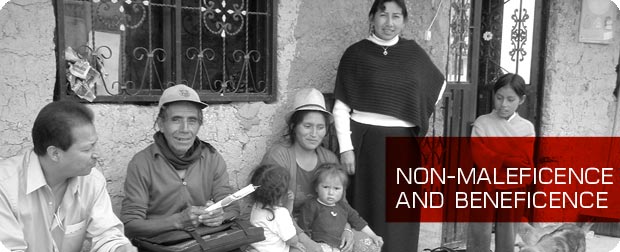The principle of “Non-Maleficence” requires an intention to avoid needless harm or injury that can arise through acts of commission or omission. In common language, it can be considered “negligence” if you impose a careless or unreasonable risk of harm upon another. The “Beneficence” principle refers to actions that promote the well-being of others.The duty of professionals should be to benefit a party, as well as to take positive steps to prevent and to remove harm from the party.
Non-maleficence reminds you that the primary concern when carrying out a task is to do no harm. Beneficence promotes action that will support others. These two theories taken together state that you must act in a manner that cultivates benefit for another, and at the same time protects that person from harm. A single action can be analyzed and balances through both frameworks. You must look to reduce and eliminate negative impact of what work is being done and simultaneously find the means to support the welfare of the recipient. If you neglect to control certain aspects of your work that have undesirable and harmful consequences upon others then you are not abiding by the principle of non-maleficence.
Similarly, in the case of beneficence, if you attempt to carry out a task in a given environment, you must be sure that your action has positive impact in that context. These theories discourage selfish behavior which may directly or indirectly harm or deprive a recipient community. Notions of harm and benefit are molded by context, and thus cultural, economic, social, religious, political and other factors tie into how non-maleficence and beneficence are used for ethical decision-making. Many situations encountered by students and others during international engagement fall into the boundaries of these two theories. In all cases you must avoid action that may be harmful (non-maleficence) and attempt to carry out action that will benefit a host community (beneficence).
Non-maleficence and beneficence support the consideration of sustainability from a social, economical and ecological perspective. ISL projects are “sustainable” when they avoid a a relationship of dependence between the community partners. Dependency relationships may be harmful for the people or environment once the organization where services are provided withdraw their help.
Example:A volunteer gives toothbrushes and toothpaste to a rural community and educates them about dental health. However, the toothpaste is quickly used up and the community has no access to commute to town to purchase toothpaste so they burn their plastic tooth-brushes along with the rest of their garbage in the backyard creating harmful fumes (burning of certain plastics can create dioxins-a human carcinogen).
“Non-Maleficence” and “Beneficence” frameworks encourage the sharing of appropriate and effective intercultural knowledge. This prevents mis-communication and the harm that can arise from being cultural miscommunication . Locals often have more knowledge than volunteers on the subjects the volunteers have come to teach. Without cultural knowledge, service-learning projects cannot deliver effective information or know what negative impacts may be involved.
Example: A short-term health-promotion project may be appropriate when aiding an already established project (eg. supporting a local educator) that has asked for help in pre-identified areas. However, this project may be ineffective and possibly damaging when the service providers are interacting firsthand with communities they know little about.
“Non-maleficence” relates to the theme of “Balance and Reciprocity” because students must make sure that what they hope to learn and fulfill upon completion of their ISL project does not harm the balance dynamic is the community.
Example: Students want to experience living among the community members in a local community. However, it may not always be appropriate to ask locals to open up their homes to strangers from abroad and it may create an unfavorable power dynamic.
“Non-maleficence” relates to the theme of “Motivations” in ISL because it poses the moral objection that the use of another human being as a means to an end is unacceptable, even if the end is legitimate (fulfill a graduation requirement, enhance a résumé, and/or secure research funds).
Example: A 1st year medical student who wishes to get hands-on experience goes to Nicaragua and begins to diagnose and treat patients in an understaffed urban clinic with little supervision.
“Non-maleficence” supports the idea that students understand what they can actually offer as student volunteers and their actions do not exceed what is acceptable based on their training and education. This is especially relevant when volunteers present themselves as educators. Students should reflect on whether their work in a international setting would be considered acceptable at home based on their level of training.
Example: A group of science students wishes to address the health needs of the community and comes to a conclusion that the primary school in the community needs a washroom. They soon begin building the lavatory but is unsuccessful in finishing because they run into various logistical and mechanical obstacles due to their limited experience in construction and plumbing. The project is left unfinished before the volunteers leaves.
